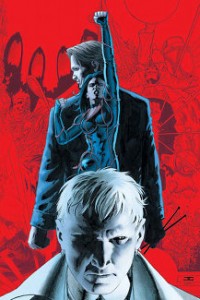There has scarcely been a better time for the superhero genre. Even if your movie turns out to be a “flop,” you can still guarantee a #1 weekend slot at the box office on your eventual way to digital streaming services. Marvel Studios is one of the biggest producers in the industry — a far cry from when they were owned by New World Cinema, the company that  brought you the House horror series way back in the ’80s. DC, now fully embraced by parent company Warner Bros., is not far behind and is threatening to overtake Marvel with the introduction of the rival gang that is the Justice League.
brought you the House horror series way back in the ’80s. DC, now fully embraced by parent company Warner Bros., is not far behind and is threatening to overtake Marvel with the introduction of the rival gang that is the Justice League.
Notice how, in no point of the previous statement, I dug into the aspect that these were comic characters. They aren’t, at least, not anymore. They were once, most especially when the first Superman movie hit screens in the late 1970’s. Comics were the source material from which films came, or attempted to come, as the following decades would show. Most projects were stillborn. Some, like a cruelly laughable attempt at Captain America, probably should have been stillborn. But now, the movies are the source material to large extent and the comics are a product of afterthought, another piece of the merchandising puzzle. As such, the past ten to twenty years saw steady declines in book sales.
 There are some reasons for it. The first is content, and in some ways the comics have never been as literate or as engaging as they are now for adults. Series like Brian K. Vaughn and Fiona Staples’ Saga or Frankenstein Alive! Alive! from Steve Niles and comics legend Bernie Wrightson, and the groundbreaking work from years past like Neil Gaiman’s total demolition and reconstruction of DC’s Sandman into a rumination on mythology itself are rightly considered literature. There are more out there, but comics have taken a near-permanent dark turn.
There are some reasons for it. The first is content, and in some ways the comics have never been as literate or as engaging as they are now for adults. Series like Brian K. Vaughn and Fiona Staples’ Saga or Frankenstein Alive! Alive! from Steve Niles and comics legend Bernie Wrightson, and the groundbreaking work from years past like Neil Gaiman’s total demolition and reconstruction of DC’s Sandman into a rumination on mythology itself are rightly considered literature. There are more out there, but comics have taken a near-permanent dark turn.
I blame Frank Miller. His revolution in four issues, The Dark Knight Returns showed a sinister, flawed, anti-heroic side to the Batman, who for years before had come closer to Superman in dark tights than a dark knight. That miniseries showed that the audience was ready for changes, for tonal shifts, and they could handle a few rugs being tugged out from underneath them. It showed that DC could take risks, and they did, and were respected for it. And yet we have suffered through iteration after iteration of flawed, angry, violent heroes since. That the character of these characters is so lacking, so morally flimsy, may be a better reflection of how corrupt our modern, real-world heroes are, but it has crossed into a world without counterbalance.
The Dark Knight Returns was powerful because we had, for years, a Batman without edges; not quite the campy, Adam West variety, but hardly the blood-spilling and spit-drooling wraith we have now. We had to grow with the character in one way before we could really feel the impact of change in the other way. If every hero is just a psycho with re-channeled purpose, there isn’t much to depart from.
 Once Pandora’s Box had been opened and the world of the morally ambiguous hero was let loose, the “comic book store” became fully institutionalized. There had been comic book stores for many years, and they made their money primarily on the resale of back issues, but with darkening shades of superheroes, along with the increase of sexual content, graphic violence and heightened language, these markets became places where those books could only be sold. The content was too much to bear for the newsstand Comics Code Authority guidelines of decency.
Once Pandora’s Box had been opened and the world of the morally ambiguous hero was let loose, the “comic book store” became fully institutionalized. There had been comic book stores for many years, and they made their money primarily on the resale of back issues, but with darkening shades of superheroes, along with the increase of sexual content, graphic violence and heightened language, these markets became places where those books could only be sold. The content was too much to bear for the newsstand Comics Code Authority guidelines of decency.
At the same time, publishers started withdrawing from the newsstands. Why continue to publish books with such built-in limitations? Well it turns out there’s a very good reason why. The newsstand, or the convenience store, or the grocery store was the gateway for the original waves of hardcore fans. They grew up with this stuff as kids, and that was because comics were an impulse purchase. Parents bought them the books to “shut the whining, nagging brats up.” These racks were not segregated to the far corners of these stores. They were shoved right up front, one of the first things seen, to rile the kids up in the first place. The reason why adults appreciated the more adult Batman was because they grew up with the less adult Batman, and did so as an appeasement for the children who browbeat their weary parents. Comics were cheaper than water pistols, safer than bang-caps, and wouldn’t rot teeth like candy and Bubble Yum bubble gum did.





Comments